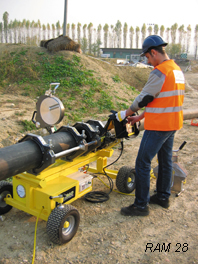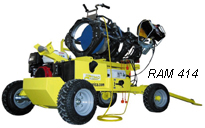|
HDPE Pipe Expands In North America
HDPE pipe is a cost-effective solution for a broad
range of applications in gas distribution, municipal,
industrial, marine, mining, landfill, duct,
drainage, plumbing and heating applications. It has been
tested and proven effective for above ground, surface,
buried, sliplined floating and sub-surface marine applications.
Gas distribution was among the first applications of
medium density polyethylene (PE) pipe. In fact, many of
the systems currently in use have been in continuous service
since 1960 with great success. Today, over 90% of the
pipe installed for the natural gas distribution industry in
the U.S. and Canada is plastic and of that, 99% is polyethylene*.
HDPE pipe has been used in potable water applications
since the 1960s and has been gaining approval and
growth in municipalities ever since. HDPE Pipe is specified
and/or approved in AWWA C901, AWWA C906, NSF 14,
NSF 61 and ASTM D3035.
One of the main benefits and advantages of HDPE pipe
is that it is a heated fusion joint; HDPE pipe can be heat
fused together to form a joint that is as strong or stronger
than the pipe itself and is leak free.
Main joining methods are through hot plate welding,
such as butt-fusion, saddle fusion and socket fusion. Butt
fusion machines are available from 1/2” to 54” for job-site
and work-shop applications such as fabricated fittings
productions. Socket fusion equipment is available up to 4”
pipe sizes.
Since the 1960s, butt-fusion technology has seen a
transformation and adaptation of the equipment to the
market needs, moving from manual pump or mechanical
equipment to high quality electro-hydraulics machines and
from labor intensive equipment to one man operation.
Today’s challenge is to reply to higher quality standards,
a user friendly design, lower cost and traceable results.
Today, equipment covering both HDPE pipeline fusion
and segmented fittings fabrication, enable operators to
carry out multiple task during production times, while
leaving the duties of checking and certifying performance to the automated machines, software interfaces and GPS
controls. This will result in reduced labor cost, lead time
and quality fulfillment.
Examples of this new generation of equipment are the
 RAM 28 and the RAM 414 from Ritmo America, LLC, job
site butt fusion machines.
RAM 28 and the RAM 414 from Ritmo America, LLC, job
site butt fusion machines.
The RAM 28 is an electro-hydraulic butt fusion machine
with fusion capabilities ranging from 2” IPS to 8” DIPS
pipe sizes, RAM 414 range from 4” IPS to 14” IPS.
Both machines are provided with a unique and innovative
programming and control system. The system permits
the operator to program and perform all of the fusion procedures
quickly and easily. The program/control panel
allows the operator to set the machine for heating temperature,
facing pressure, heating time, soaking time,
fusion pressure and cooling time. It incorporates a datalogging
device to record all the fusion cycle information
that can be downloaded to a PC or laptop.
In this way, customers can constantly be aware of any
welding operation cost and certify the quality of their
 products.
products.
The machine body and
clamping system can
be easily removed
from the 4-
wheeled frame
and chassis
for in-ditch
use: the control
panel
can also be removed from the chassis to allow the operator
to control the fusion procedures out of the ditch.
In addition, the RAM 414 features a Global Positioning
System (GPS), self-contained generator and motorized
wheels. GPS offers great advantages for tracking a fusion
joint – giving a report with the coordinate of where the
joint has been performed. A gasoline, self-contained generator
mounted on the machine and the motorized wheels
allow the operator to move the butt-fusion equipment
faster and more safely on different and difficult job site
terrain.
PE is the worldwide material of choice. High-density
polyethylene pipe (HDPE) can carry potable water, wastewater,
slurries, chemicals, hazardous wastes and compressed
gases. In fact, polyethylene pipe has a long and
distinguished history of service to the gas, oil, mining and
other industries. It has the lowest repair frequency per
mile of pipe per year compared with all other pressure
pipe materials used for urban gas distribution.
*Source: Plastic Pipe Institute
Written by Andre Muraro, General Manager, Ritmo
America, LLC, suppliers of a comprehensive line of fusion
machines and accessories for pipe installation, dedicated
exclusively to the North American Market of HDPE, PP,
PVDF pipe, fittings and plastic thermo fusion.
For more information, contact Ritmo America, LLC,
300 Acuff Road, Lake Wales, FL 33859, 863-679-8655,
Fax: 863-679-8685, E-mail: info@ritmoamerica.com,
Web: www.ritmoamerica.com.
|